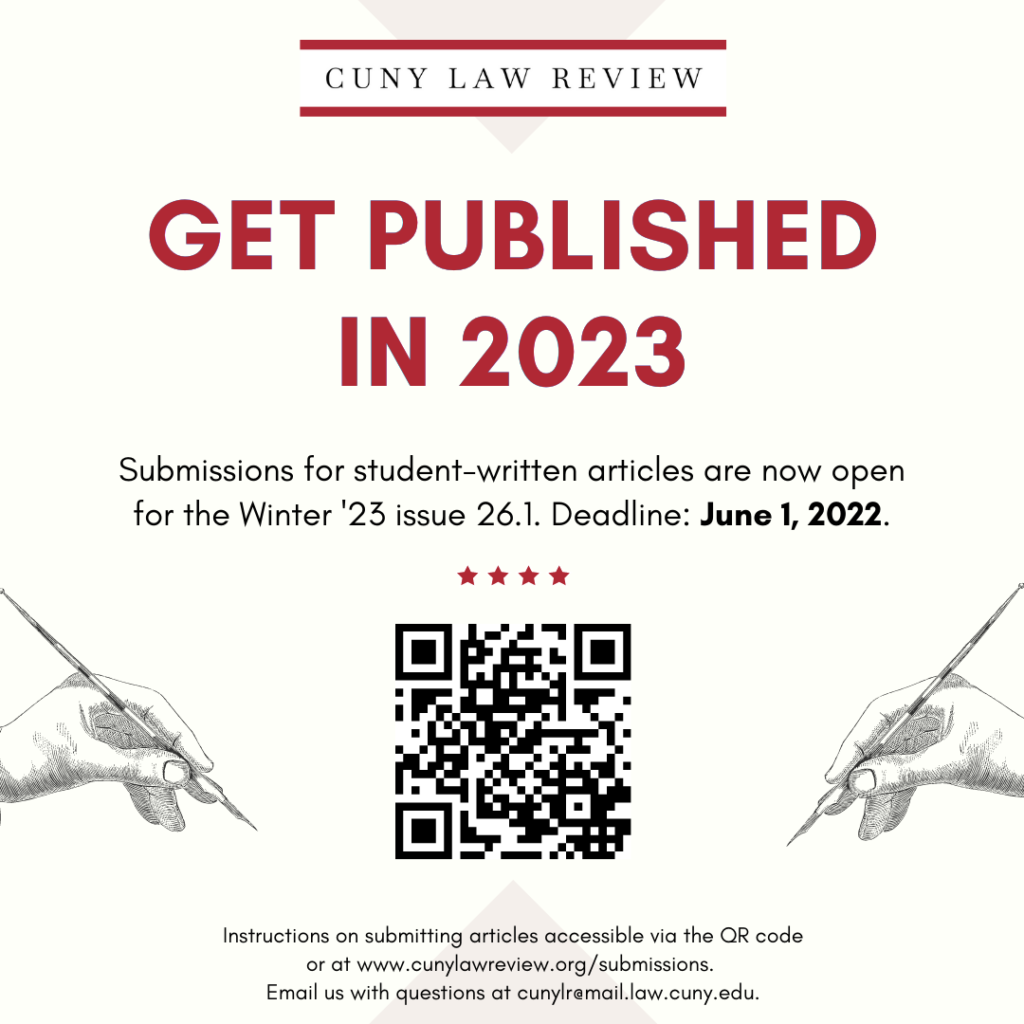On Feb. 21, 2023, the Supreme Court heard arguments in Gonzalez v. Google and Twitter Inc., v. Taamneh, a set of companion cases which turn on the question of whether social media platforms can be held liable for hosting harmful terrorist material. CUNY Law Student Val Rigodon (‘22) wrote a note in our 25.2 issue that was cited in the amicus brief submitted by Tennessee and other states.
Category Archives: Student Contribution
Call for Student Submissions – Volume 26.1

Interested in getting published in CUNY Law Review? We are currently accepting submissions for student-written articles to be published in our Winter 2023 issue (26.1). CUNY Law Review seeks to uplift student authors and welcomes submissions from all law students for the Notes and Comments section. Students are encouraged to see Notes and Comments as a platform to publish their work, along with the Footnote Forum and the CUNY Law Review Blog!
Submissions should be emailed to salimah.khoja@live.law.cuny.edu and sulafa.grijalva@live.law.cuny.edu no later than June 1st. For general questions, please email cunylr@mail.law.cuny.edu.
Scan the QR code for more details!
How Coronavirus Created and Exposed Issues with Supplemental Security Insurance and the Social Security Administration
By Emma Mendelson1
The pandemic left many poor and working-class people in precarious financial positions. The federal government attempted to alleviate some of these financial burdens through Economic Impact Payments (“EIP”) providing people with three stimulus checks in 2020 and 2021. As paltry and unrealistic as these payments were (a maximum of $1,200, $600, and $1,400 for households of one, $2,400 for a married couple, and up to $500 additional for each qualifying child) in supporting the financial loss felt by many, it was at least an act meant to mitigate some of that burden. However, this caused some unforeseen damage to recipients of Supplemental Security Insurance (“SSI”).
Continue readingSPACE LAW AND THE FUTURE OF PUBLIC INTEREST
Mclee Kerolle*
Click here for a recommended citation and to download a paginated PDF version of this article.
Introduction
On April 10, 2013, the Obama Administration released its proposed budget for 2014 with initial reviews showing that there would be a $200 million cut for NASA’s planetary exploration program.[1] Critics against the cut, such as Planetary Society CEO Bill Nye, have spoken out about the crippling effect the cuts will have on future missions and the cuts potential to reverse a decade’s worth of investment building the world’s premier exploration program.[2] On the other hand, proponents of the budget have praised it for its approval of $105 million for a mission to capture an asteroid so that it can be explored by 2015, as well as its funding for ongoing human spaceflight and support for private space taxis that could launch astronauts to and from the International Space Station.[3] Irrespective of the divisions the budget proposal has caused among those in the space industry, one thing is for certain: the space industry is going through a resurgence. Not since the Space Race has there been more of a reason for people to be excited about what lies ahead. Rightfully so, considering that despite budget cuts and perceived setbacks from the public (such as the retirement of NASA’s space shuttle program in 2011) the space industry is now a $250 billion per year global market.[4]
